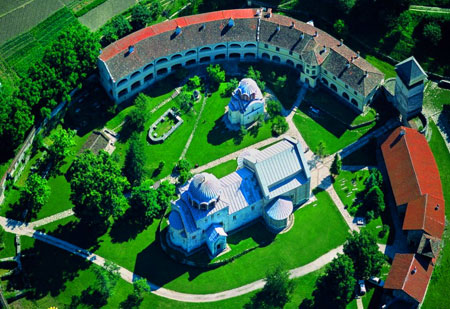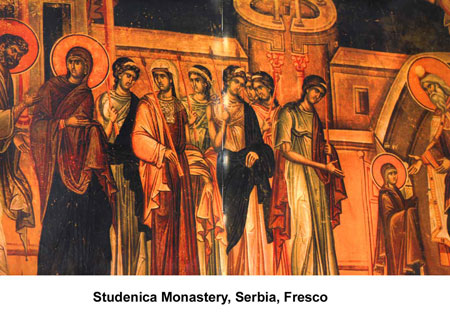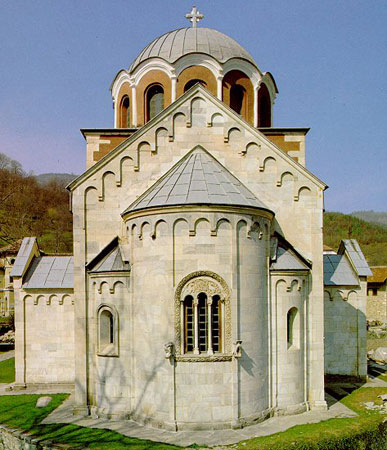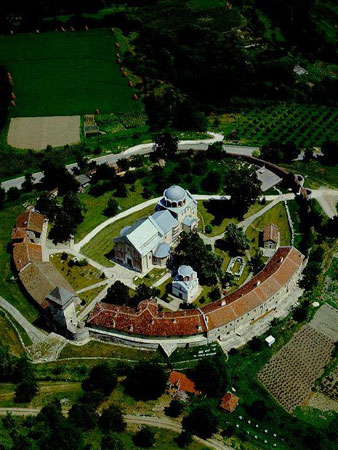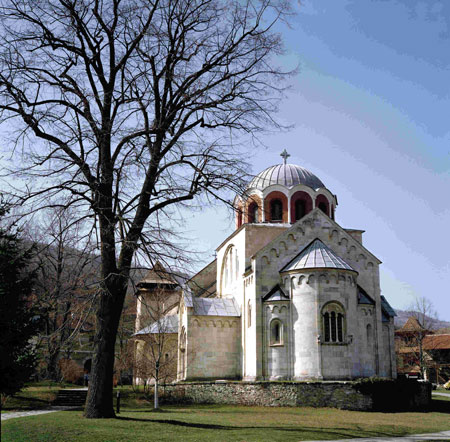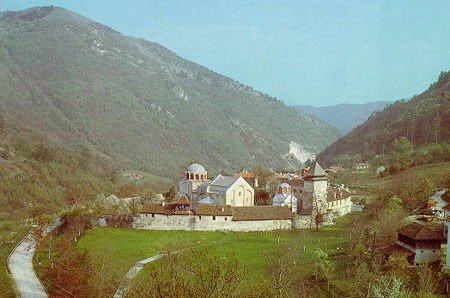The Monastery Studenica - Манастир СтуденицаThe Monastery Studenica
(King Milutin)
The monastery Studenica, dedicated to the Presentation of the Holy Virgin, is the mother-church of all Serbian temples. It was constructed over a quite long period. The first stage works were completed by the spring of 1196, when Stefan Nemanja abandoned his throne and settled in the monastery's foundation. When he later left for Hilandar, his son and successor Stefan took over the care of Studenica. Nemanja died in Hilandar in 1299. Nemanja's third son Sava, after reconciling his brothers Stefan and Vukan, moved Stefan's relics to Studenica. Under guardianship of Sava, Studenica became the political, cultural and spiritual center of medieval Serbia. Among his other endeavors, Sava composed a Typik, the rule-book where he described St. Simon's life, leaving evidence of the spiritual and monastic life of his time.
Studenica enjoyed continual care by the members of the Nemanjic dynasty. King Radoslav added to the church a splendid narthex in 1235. King Milutin built a small but lovely church dedicated to saints Joachim and Anna.
Since the fall of the last of the medieval Serbian states in 1459, the Turks often assaulted the monastery. The first of the significant restorations of the damage took place in 1569, when the frescoes in the Church of the Presentation were repainted. In the early seventeenth century, an earthquake and a fire befell the monastery, and historical documents and a significant part of the artistic heritage were destroyed and lost forever.
The Virgin's Church is a domed single-nave basilica. At its eastern end there is a three-sided apse, while an extended narthex faces west; there are also vestibules on the north and the south. In the 1230s, a large exonarthex was added. The facades were built with slabs of white marble; inside, the church is revetted with tufa blocks. Externally, the Church harmoniously reconciles two architectural styles, the Romanesque and the Byzantine. The blending of these two styles eventually produced a particular style of architecture known as the Raska School.
The artistic achievements of the sculpture of Studentica culminate in four portals, primarily the west one, inside between the narthex and the exonarthex. On the north wall under the dome, there is a window made of many square panes with medallions carved on a leaden plaque which represent eight fantastic animals - the symbols of the Virgin's virtues. There are also two rosettes denoting the Divine Eye. The masons came to Studenica most probably from the Adriatic region, perhaps from Kotor, where Nemanja used to have a palace. They left an insciption in Serbian lettering on the tympanum of the west portal.
The church was painted in the first decade of the thirteenth century. The original frescoes have been partly preserved in the altar area, under the dome, on the west wall, and in the lower registers of the nave. The most splendid representation is that of the Crucifixion, painted on blue background in 1209, one of the paramount achievements in Serbian art. On the south wall there is the "founders' composition" which shows the Virgin taking Nemanja-Simon with the church model to Jesus Christ as the Magistrate Impartial.
The narthex was painted in 1569. Those frescoes include an exquisite representation of the Last Judgment in the upper registers, and the portrait of Nemanja's wife Ana as the nun Anastasija.
The earliest fresco painting in Studenica marks the supreme achievement of Byzantine art in the region. The frescoes in Radoslav's narthex and the pareclesions originate from the 1230s and display a close relation to the painting style of the main church. The north chapel, dedicated to St. Nicholas, contains a composition of the Hetimasia and a cycle dealing with the life of St. Nicholas. In the south chapel one finds the portraits of Nemanja, Stefan the First Crowned and King Radoslav with his wife Ana. On the north wall of the narthex, three dignitaries of the Serbian church are portrayed - the archbishops Sava, Arsenije and Sava II (Radoslav's brother).
Northward from the Studenica refectory is the eighteenth century monastic residence, now housing a museum and displaying a number of the precious exhibits from the Studenica treasury. However, the frequent wars and plunders have considerably reduced the richest depository of Serbian spiritual life and culture in general.
Northwest of the Church of the Virgin there is the church of saints Joachim and Ann, known after its founder King Milutin as the King's Church. The church was constructed in 1314, in the form of a compressed cross, with the exterior structure of an octagonal dome. It is built of stone and tufa, with plastered facades. Inside this small church are frescoes of significant value, which date from the second half of the fourteenth century, painted by King Milutin's favorite artists.
The complex of the Studenica monastery includes the Church of St. Nicholas, a small single-nave church frescoed inside with works from the twelfth or possibly early thirteenth centuries. Between the Church of St. Nicholas and the King's Church are the foundations of the church dedicated to St. John the Baptist. West of the Virgin's Church, there is an old refectory made of rubble, built during the time of Archbishop Sava. Finally, on the western side of the monastery complex there is a bell tower, erected in the thirteenth century. There used to be a chapel inside; now, only fragments of frescoes can be seen there. Remains of fresco painting have also been numbered on the external part of the narthex, splendidly representing the Nemanjic dynasty genealogy. They obviously relate to the frescoes from the Virgin's Church which date back to 1208-9.
Манастир Студеница
Манастир Студеница је манастир Српске православне цркве који се налази 39 km од Краљева. Студеница је један од највећих и најбогатијих манастира Српске православне цркве.
Манастир је 1190. основао Стефан Немања. Утврђени зидови манстира окружују две цркве: Богородичну цркву и цркву Светог Јоакима и Ане (Краљева црква). Обе цркве су изграђене од белог мермера.
Богата збирка богослужбених предмета и икона изложена је у манстирској ризници.
У манстирском комплексу Студенице налазе се још две цркве.
Мала црква посвећена Светом Николи која је грађена почетком XIII века са сачуваним фрагментима фресака из четврте деценије XIII века.
Црква Св. Јоакима и Ане – Краљева црква, сазидана 1313/14.године у време краља Милутина по коме је и добила име. Квадратне је основе са добро сачуваним живописом који представља право ремек дело сликарског стила ренесансе Палеолога.
Манастир је познат по својој колекцији фресака из 13. и 14. века.
УНЕСКО је 1986. уврстио Студеницу у листу Светске баштине.
Манастир Студеница је посвећен Успењу пресвете Богородице. Прва фаза радова је завршена у пролеће 1196, када је Стефан Немања препустио прество свом сину Стефану Првовенчаном и повукао се у своју задужбину. Кад је касније отишао у манастир Хиландар, Стефан Првовенчани се бринуо о Студеници. Тамо је Немања примио монашки постриг и име Симеон. Свети Симеон се упокојио у Хиландару 1199. Немањин трећи син Сава Немањић је, након што је помирио своју браћу Стефана и Вукана, пренио мошти Светог Симеона у Студеницу где су и дан данас. Под Савиним старатељством, Студеница је постала политички, културни и духовни центар средњовековне Србије. Уз остала своја дела, Сава је написао Студенички типик, у ком је описао живот свог оца Немање, оставивиши изворе о духовном и монашком животу у његовом времену.
Студеница је уживала пажњу и другх чланова династије Немањића. Краљ Радослав је 1245. додао цркви припрату, а краљ Милутин је саградио малу цркву посвећену светим Јоакиму и Ани.
Од пада последње српске средњовековне државе 1459, Турци су често нападали манастир. Прва значајна рестаурација је извршена 1569, када су фреске Богородичине цркве поново насликане. Почетком 17. века, пожар и земљотрес су оштетили манасти, а историјски документи и значајни делови уметничке баштине су уништени и изгубљени заувек.
Патрон и изградња: Студеницу, цркву посвецену Богородици Добротворки је измеду 1183. и 1191.године, подигао велики жупан Стефан Немања као своју главну задужбину и династицки маузолеј.
Дуго времена је Студеница била узор потоњим задужбинарима, Немањиним наследницима који су своје задужбине градили по њеном узору.
